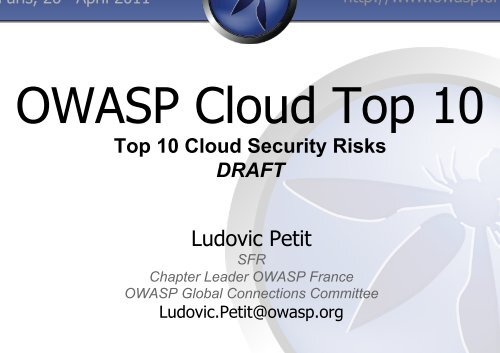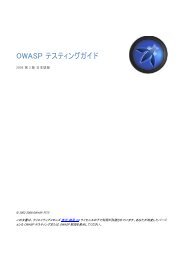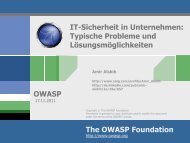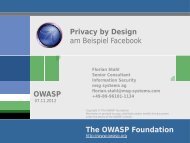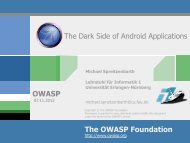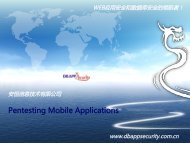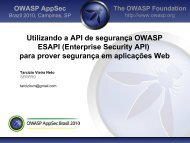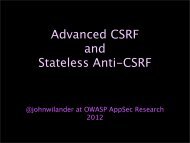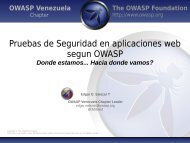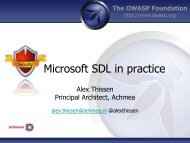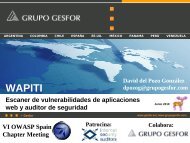OWASP Cloud Top 10.pptx
OWASP Cloud Top 10.pptx
OWASP Cloud Top 10.pptx
Create successful ePaper yourself
Turn your PDF publications into a flip-book with our unique Google optimized e-Paper software.
aris, 26 April 2011<br />
http://www.owasp.org<br />
<strong>OWASP</strong> <strong>Cloud</strong> <strong>Top</strong> 10<br />
<strong>Top</strong> 10 <strong>Cloud</strong> Security Risks<br />
DRAFT<br />
Ludovic Petit<br />
SFR<br />
Chapter Leader <strong>OWASP</strong> France<br />
<strong>OWASP</strong> Global Connections Committee<br />
Ludovic.Petit@owasp.org
About me<br />
• Group Fraud & Information Security Adviser at SFR<br />
• Member <strong>OWASP</strong> Global Connections Committee<br />
• Translator of the <strong>OWASP</strong> <strong>Top</strong> Ten<br />
• Chapter Leader <strong>OWASP</strong> France<br />
• Contributions & Reviews<br />
- <strong>OWASP</strong> Secure Coding Practices - Quick Reference Guide<br />
- <strong>OWASP</strong> Mobile Security Project<br />
- <strong>OWASP</strong> <strong>Cloud</strong> <strong>Top</strong>10 Project
Agenda<br />
• Motivation<br />
• <strong>Cloud</strong> <strong>Top</strong> 10 Security Risks<br />
• Summary & Conclusion<br />
• Q&A
Motivation<br />
Develop and maintain <strong>Top</strong> 10 Risks with <strong>Cloud</strong><br />
Serve as a Quick List of <strong>Top</strong> Risks with <strong>Cloud</strong> adoption<br />
Provide Guidelines on Mitigating the Risks<br />
Building Trust in the <strong>Cloud</strong><br />
Data Protection in Large Scale Cross-Organizational System
<strong>Cloud</strong> <strong>Top</strong> 10 Risks<br />
• R1. Accountability & Data Risk<br />
• R2. User Identity Federation<br />
• R3. Legal & Regulatory Compliance<br />
• R4. Business Continuity & Resiliency<br />
• R5. User Privacy & Secondary Usage of Data<br />
• R6. Service & Data Integration<br />
• R7. Multi-tenancy & Physical Security<br />
• R8. Incidence Analysis & Forensics<br />
• R9. Infrastructure Security<br />
• R10. Non-production Environment Exposure
R1. Accountability & Data Risk<br />
itional data center of an organization is under complete control of that organization.<br />
rganization logically and physically protects the data it owns.<br />
ganization that chooses to use a public cloud for hosting its business service loses control o<br />
oses critical security risks that the organization needs to carefully consider and mitigate.<br />
ust ensure about the guarantee of recovering Data:<br />
Once the data entrusted to a third operator, what are the guarantees that you will recover<br />
information?<br />
What about the backups performed by the operator of <strong>Cloud</strong>?
R2. User Identity Federation<br />
ery important for the enterprises to keep control over user identities as they move services<br />
ations to the different cloud providers.<br />
r than letting <strong>Cloud</strong> providers create multiple islands of identities that become too comple<br />
ge down the line.<br />
should be uniquely identifiable with a federated authentication (e.g. SAML) that works across<br />
providers.<br />
experience is enhanced when he/she does not manage multiple userids and credentials. This al<br />
back-end data integrations between cloud provides.
R3. Legal & Regulatory Compliance<br />
lex to demonstrate Regulatory compliance.<br />
that is perceived to be secure in one country may not be perceived secure in another du<br />
ent regulatory laws across countries or regions.<br />
stance, European Union has very strict privacy laws and hence data stored in US may not co<br />
hose EU laws.
R4. Business Continuity & Resilency<br />
ess Continuity is an activity an IT organization performs to ensure that the business can<br />
cted in a disaster situation.<br />
e of an organization that uses cloud, the responsibility of business continuity gets delegated to<br />
provider.<br />
reates a risk to the organization of not having appropriate business continuity.<br />
Service Continuity and QoS, one have to ensure about<br />
the contractual solutions proposed by the Operator of <strong>Cloud</strong>,<br />
the Service Level Agreement as well
R5. User Privacy & Secondary Usage of Data<br />
personal data gets stored in the cloud as users start using social web sites. Most of the social<br />
gue about how they will handle users personal data.<br />
onally most of the social sites go with the default share all (least restrictive) setup for the user.<br />
kedIn, Twitter, Facebook it is very easy to deduct personal details of the users.<br />
eed to ensure with your <strong>Cloud</strong> providers what data can or cannot be used by them for secon<br />
ses.<br />
ludes data that can be mined directly from user data by providers or indirectly based on<br />
ior (clicks, incoming outgoing URLs, etc.).<br />
social application providers mine user data for secondary usage e.g. directed advertising<br />
er when many of us use their personal gmail/hotmail or yahoo account to tell a friend your vaca<br />
and immediately you start seeing advertisements on hotels/flights near your destination.
R6. Service & Data Integration<br />
izations must be sure that their proprietary data is adequately protected as it is transfe<br />
en the end user and the cloud data center.<br />
interception of data in transit should be of concern to every organization, the risk is much gre<br />
ganizations utilizing a <strong>Cloud</strong> computing model, where data is transmitted over the Internet.<br />
ured data is susceptible to interception and compromise during transmission.
R7. Multi-tenancy & Physical Security<br />
tenancy in <strong>Cloud</strong> means sharing of resources and services among multiple clients (<br />
rking, storage/databases, application stack).<br />
reases dependence on logical segregation and other controls to ensure that one tenant deliber<br />
dvertently can not interfere with the security (confidentiality, integrity, availability) of the o<br />
ts.
R8. Incidence Analysis & Forensics<br />
event of a security incident, applications and services hosted at a <strong>Cloud</strong> provider are difficu<br />
igate as logging may be distributed across multiple hosts and data centers which could be loc<br />
ious countries and hence governed by different laws.<br />
along with log files, data belonging to multiple customers may be co-located on the same hard<br />
torage devices and hence a concern for law enforcing agencies for forensic recovery.
R9. Infrastructure Security<br />
rastructure must be hardened and configured securely, and the hardening/configuration base<br />
d be based on Industry Best Practices.<br />
ations, Systems and Networks must be architected and configured with tiering and security zo<br />
ccess must be configured to only allow required network and application protocols.<br />
istrative access must be role-based, and granted on a need-to-know basis. Regular<br />
sments must be done, preferably by an independent party.<br />
icy and process must be in place for patching/security updates, and can based on risk/th<br />
sments of new security issues.<br />
gh the fine details of the items above must be regarded as highly sensitive information,<br />
nable to expect a customer to want to see at least the high-level details.<br />
rovider must be willing to provide this.
R10. Non-production Environment Exposure<br />
organization that develops software applications internally employs a set of non-produ<br />
nments for design, development, and test activities.<br />
on-production environments are generally not secured to the same extent as the produ<br />
nment.<br />
organization uses a <strong>Cloud</strong> provider for such non-production environment, then there is a high<br />
uthorized access, information modification, and information theft.
Summary &<br />
Conclusion
Summary<br />
ud computing is a new way of delivering computing resources, not a new technology.<br />
uting services (ranging from data storage and processing to software, such as email handling<br />
vailable instantly, commitment-free and on-demand.<br />
hecklist should provide a means for customers to<br />
Assess the risk of adopting <strong>Cloud</strong> Services<br />
Compare different <strong>Cloud</strong> provider offerings<br />
Obtain assurance from selected <strong>Cloud</strong> providers<br />
Reduce the assurance burden on <strong>Cloud</strong> providers
Q&A
Want to contribute or provide feedback?<br />
Ludovic.Petit@owasp.org<br />
The <strong>OWASP</strong> <strong>Cloud</strong> <strong>Top</strong> 10 Project<br />
s://www.owasp.org/index.php/Projects/<strong>OWASP</strong>_<strong>Cloud</strong>_%E2%80%90_10_Proje


